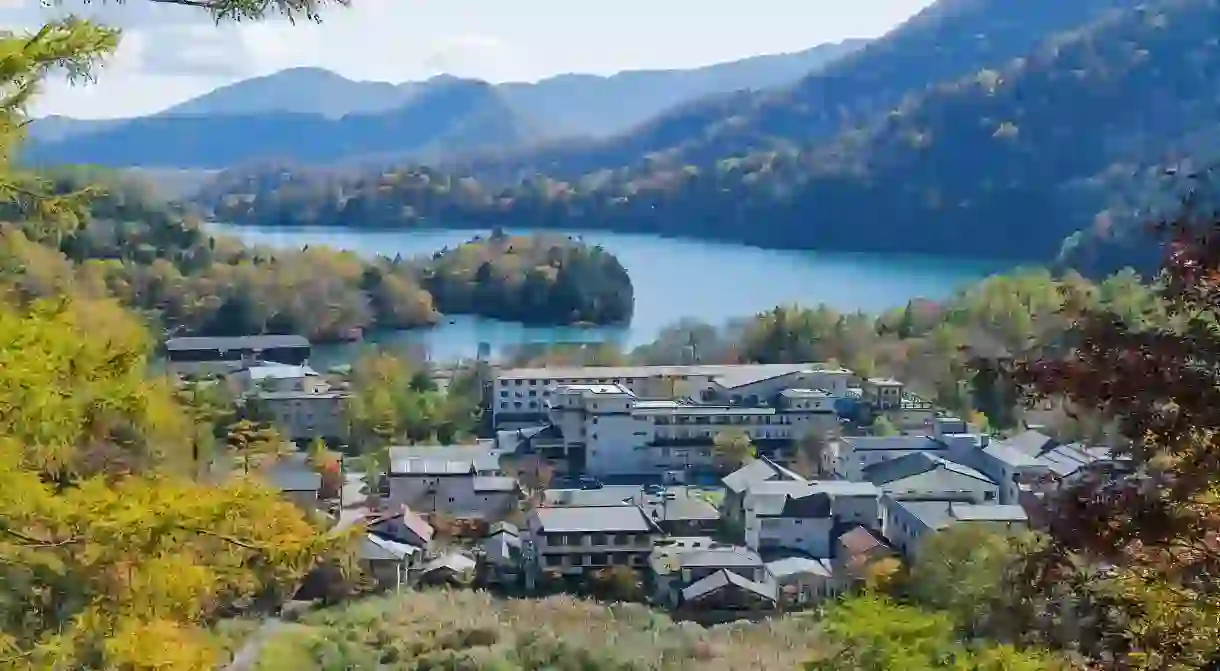What To Do on a Day Trip to Hakone

From exploring Japan’s first outdoor sculpture park to soaking in an onsen and slurping up soba noodles, here’s how to spend a perfect day in Hakone.
Please note: the Hakone Tozan Line between Hakone-Yumoto and Gora is currently closed until autumn 2020 due to a typhoon in the region. Replacement bus and rail services are available. For updates, check their website.
Morning
Discover art and nature at the Hakone Open-Air Museum
Every trip to Hakone begins at Hakone-Yumoto station, to where many people travel from Tokyo. Yumoto, home to several bathhouses and inns and Hakone’s oldest hot spring, is the gateway to the wider Hakone region. From here, buy a ticket for the Hakone Tozan Railway, and enjoy the spectacular hour-long ride through valleys and forestland as the mountain railway climbs uphill to Gora station.
Top tip: if you’re looking to cover the entire Hakone loop on your day trip, purchase the Hakone Free Pass from Shinjuku Station. The pass covers you for two to three days and gives you unlimited access to all the means of transport in the Hakone region, including the Hakone Tozan Cable Car and the Hakone Ropeway.

Gora is one Hakone’s main hot spring resorts, home to several stylish ryokans, a Western-style namesake park and the Hakone Museum of Art. While the museum and gardens in Gora are worth a visit, the main attraction is the nearby Hakone Open-Air Museum, which is just a 15-minute walk from Gora station. Spend your morning exploring all 70,000 acres (28,000ha) of Japan’s first outdoor sculpture park, which features sculptures by Henry Moore, Barbara Hepworth, Kyoko Asakura and several other notable artists, backdropped by the verdant hills and forests of Hakone. The al fresco artworks are joined by an entire pavilion dedicated to Spanish painter Pablo Picasso, plus a hot spring foot bath and an all-you-can-eat café for lunch, with sweeping views over the sculpture park and mountains.
Afternoon
Soar over Ōwakudani, Hakone’s active volcanic valley, and get that postcard-perfect shot of Hakone Shrine
Hop on the Hakone Tozan Cable Car from Gora Station to Sōunzan Station, from where you can board the Hakone Ropeway, an aerial cable car that glides over Ōwakudani before terminating at Togendai Station at the edge of Lake Ashinoko. Disembark at Ōwakudani Station and try one of the region’s special black eggs, which are hard-boiled in sulfurous hot springs and said to add seven years to your life. They can be found cooking away in souvenir shops dotted around the valley.


Once you’ve had your fill of eggs and vistas over the volcanic crater, take the Hakone Ropeway to Togendai Station, from where you can board a ship that takes in views of Mount Fuji and Hakone Shrine‘s iconic red gate on Lake Ashinoko. Make sure you’ve packed your camera: there are plenty of excellent photo opportunities on this hour-long cruise.
Evening
Wind down in a traditional hot spring bath in Yumoto
From Togendai Station, take the 25-minute ropeway back to Sōunzan Station. The Hakone Tozan Cable Car will get you back to Gora in 10 minutes, from where you can travel back through the mountains to Hakone-Yumoto.
A must-do on any visit to Hakone is a soak in a traditional onsen. Hakone is one of Japan’s most famous hot spring towns, with seventeen spring water sources powering baths and heated pools in ryokans and bathhouses across the region. The hot spring at Yumoto has a particularly long history, and dipping into a hot bath in one of Yumoto’s several day spas is the perfect way to wind down after a day of sightseeing. Tenzan Onsen is regarded as one of the better public bathhouses, offering open-air baths surrounded by lush woodland and a maze of indoor and outdoor pools to choose from.

For dinner, slurp up noodles at Hatsuhana Soba Honten, a soba restaurant that’s been serving delicious, traditional noodles made from buckwheat, eggs and jinenjo yam since 1934.













